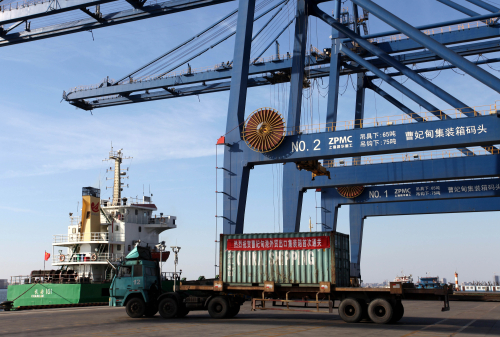 |
|
NEW EXPORT PORT: A container is loaded onto a ship to be transported to South Korea at Caofeidian Port in Tangshan, north China's Hebei Province, on March 4, marking the first shipment from the port (ZHAO YONG) |
PMI Rebounds
Chinese manufacturing business activity rebounded slightly in February but still stayed in contraction territory after falling to a 28-month low in January, official data showed on March 1.
The manufacturing purchasing managers' index (PMI), a key measure of factory activity in China, posted at 49.9 in February, up from 49.8 in the previous month, according to the data released by the National Bureau of Statistics and the China Federation of Logistics and Purchasing.
A reading above 50 indicates expansion, while a reading below 50 represents contraction.
The February index ended a falling streak lasting for four consecutive months since October 2014 and showed manufacturing contraction has narrowed.
China's service sector activity picked up in February, as the PMI for the non-manufacturing sector recovered to 53.9 in February up from 53.7 in the previous month.
Gas Pricing Policy
China will set an equal natural gas pricing structure for all industrial users to allow market forces to lead the energy sector, the top economic planner announced on February 28.
The National Development and Reform Commission (NDRC) previously launched a market-oriented energy pricing mechanism on July 10, 2013, assigning a different pricing system for existing and new factories.
This meant that longtime users enjoyed relatively low prices compared to newcomers.
To fulfill its promise to gradually level the price gap, the NDRC raised the wholesale gas price for longtime users on September 1, 2014, for the first time since the measure was put in place.
On February 28, the NDRC announced that the wholesale price for longtime users would be increased for the second time, by 0.04 yuan (less than 1 U.S. cent) per cubic meter, and new users would pay 0.44 yuan ($0.07) less starting on April 1.
After the adjustment, the price for both groups will be the same, and will rise and fall uniformly.
Standardized Farms
By the end of 2014, China had established 4,272 national-level demonstration zones over eight stages, edging it closer to its goal of agricultural standardization, said Tian Shihong, head of the Standardization Administration of China (SAC), on March 3.
Demonstration zones are large-scale farming areas set up by the SAC as model estates to test agriculture, forestry, husbandry and fishery systems to improve production capacity, according to a document published by the SAC in 2007.
The SAC encouraged local governments, leading agricultural enterprises and farmers to collaborate in the zones.
China's vision for agricultural standardization involves infrastructure construction, product circulation and information feedback, as well as brand and talent building.
"Agricultural standardization is an important step in the modernization of the sector," said Tian.
Year of the Green
China will promote clean industrial production in 2015 by encouraging green technology and more economical resource use to protect the environment, authorities said on March 4.
The Central Government will initiate a program that aims to reduce pollution, cleanse industries and prompt sustainable development this year, according to a statement published by the Ministry of Industry and Information Technology (MIIT).
Companies will consume 4 million fewer tons of coal by the end of 2015 after the ministry helps them with technological upgrades, it said.
Emission cuts including 70,000 tons of sulfur dioxide, 60,000 tons of nitrogen oxides, 40,000 tons of industrial fumes and 20,000 volatile organic compounds take place throughout the year, according to the MIIT.
The authority will prioritize aid to factories in Beijing and neighboring Tianjin Municipality and Hebei Province, as well as those in the Yangtze River Delta. Those areas have been the worst effected by smog.
